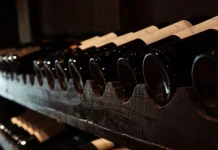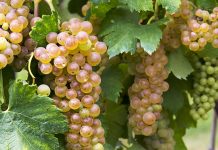Can you tell the difference between English sparkling wine and Champagne? In recent years, English sparkling wine producers have been taking the plaudits and stepping out of the shadows of their more illustrious French neighbours.
How is it possible?
Primarily they used the same grapes that French champagne vineyards have been for more than three hundred years. That is to say Chardonnay, Pinot Noir and Pinot Meunier. So English vineyards are coming up with sparkling wines to take on the very best in the business.
In 2020, Dorset winemaker Langham’s was crowned IWSC Sparkling Wine Maker of the Year beating off competition from the most famous names in the wine world.
It was an achievement not just for Langham’s but also for the entire British sparkling wine industry. This firmly established it at the top table of sparkling wine producing countries. That may not be a secret within the industry, but certainly the kind of success that lifted the profile and awareness of English sparkling wines.
Can you tell the difference between English sparkling wine and Champagne?
As respected author, wine producer and consultant wine Stephen Skelton MW, will concur.
He shared an anecdote of how he would start sparkling wine tastings with a blind taste test. Easy: a glass of both champagne and English sparkling and ask the participants to identify each drink.
As the proverb goes, the proof of the pudding is in the eating – or in this case the drinking.
The two samples would invariably come alive in the mouth. When the question was asked to choose which they felt was the better one, the majority believed it was the champagne. Only to discover it was English sparkling wine.
English sparkling wine is no longer a secret. And it is beginning to truly breakthrough as Skelton acknowledges: “The revival of the English sparkling wine industry began in the early 2000s with Nyetimber producing award-winning sparkling wines, which inspired many producers to start making Champagne-style wines.
“Without doubt, that early success has done a lot for the prestige of the product. But now you have other serious players. You have 30, 40, 50 vineyards across the country producing quality sparkling wine every year. You only have to look at the award winners to see that.”
It’s all down to the method
England’s climate and soils are reminiscent of the champagne region. Therefore, that is why it is the dominant style of wine produced in Britain.
While Hampshire’s Hambleton Vineyard is considered the ‘birthplace’ of today’s English wine industry, it is the likes of Nyetimber, which began planting vines almost 35 years ago that has driven the rise of the industry. In fact, its 260 hectares of vines across three counties are solely Pinot Noir, Chardonnay and Pinot Meunier. Moreover, these three varieties account for 60 per cent of all vines in wine production across Great Britain.
The Classic Method
Where English sparkling wines have looked to differ from other sparkling wine producing nations is by adopting what Wines of Great Britain calls the Classic Method. Indeed, as it says on its website, the method is almost entirely responsible for our remarkable status in the wine world.
“We want to celebrate this exciting style that has made us a world leader in sparkling wines and are proactively establishing Traditional Method as the authentic expression of English sparkling wine and Welsh sparkling wine, and the greatest expression of British Terroir.
“All Classic Method wines must have been produced by the same method that produces Champagne. This involves a long and complex process including two fermentations and a length of time in the cellars until they are released. It is the highest quality method of production of sparkling wine in the world.”
The Charmat Method
Another method used to produce sparkling wines in the UK is Charmat. Indeed, it is the process used in Italy to make its world-famous Prosecco.
Lizzie Mellish, author of the Budding Sommelier and former wine buyer for the English Vine, explained. “It’s a less expensive method and it is quicker to make as well. I’ve noticed it is smaller vineyards that are more likely to use this method because it doesn’t take three years as it does for a Cuvee champagne.
“Norfolk’s Flint Vineyard was the first to do this back in 2018 with a sparkling rose and other vineyards have also followed suit.”
What to choose?
While generic terms like ‘fizz’ or ‘bubbles’ or ‘champers’ may be a catch all for sparkling wine, English wine producers are not bottling just one product. The skilled winemakers across the country are bottling a variety of options for the discerning drinker.
There is the choice of sparkling wines that are either a vintage or non-vintage. Secondly, do you choose a Classic Cuvée, where the wine has been made from the traditional champagne grape varieties of Chardonnay, Pinot Noir and Meunier? Or a Cuvee made from a single grape variety? Thirdly, you could opt for an English Blanc de Blancs, a sparkling wine produced using only white grapes, which predominantly use Chardonnay. Finally, for something different, there are a small number of producers making Blanc de Noir. The latest is produced from red grapes – such a Pinot Noir or Pinot Meunier.
While the majority of the drinking options are white, there are popular rose sparkling options as well as the odd sparkling red!
Consumer demand
From leading restaurants to your local supermarket shelf, English sparkling wine (and still) is finding more and more outlets. Of course, all in addition aside from dedicated wine shops and the producers.
“You can find English sparkling wine on many wine menus nowadays. It may have been ‘fancy’ places in the past but pubs and restaurants, particularly in London and across the south, at least have one on the list,” confirmed Lizzie Mellish.
“The last five years English sparkling wine has become more accessible and you see even supermarkets now have their own brand of English sparkling wines on their shelves. People are more willing to try it. There was a time when people would be apprehensive of trying it. But it now has a good reputation and the wine is really good.”
Consequently, existing producers are expanding their vineyards. Meanwhile, newcomers are coming into the industry to not only maintain but enhance England’s sparkling wine reputation.
Which English Sparkling wine should I try?
Expert recommendations, by Lizzie Mellish
- Bolney Wine Estate (Sussex) – They produce a great Blanc de Blancs, which is a very firm favourite.
- Westwell Wine Estates (Kent). The Pelegrim NV is similar to champagne. On the palate it is very creamy and biscuity.
- Wiston Estate (Sussex). They have the talented Dermot Sugrue as head winemaker. Moreover, he produces excellent wines for Wiston as well as having his own line of Sugrue wines.
- Shotley (Suffolk) – They produced their first sparkling in 2020 using the ‘Charmat’ method. They used a blend of Auxerrois, Chardonnay, Seyval Blanc and Reichensteiner grapes.








